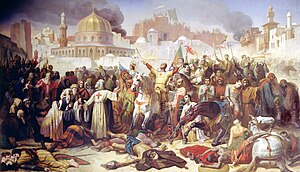
Back Belagerung von Jerusalem (1099) ALS حصار القدس (1099) Arabic Yerusəlimin mühasirəsi (1099) Azerbaijani قودس موحاصیرهسی (۱۰۹۹) AZB Обсада на Йерусалим (1099) Bulgarian জেরুসালেম অবরোধ (১০৯৯) Bengali/Bangla Setge de Jerusalem (1099) Catalan Къудс-ГӀалин гуо лацар (1099) CE Obléhání Jeruzaléma (1099) Czech Belagerung von Jerusalem (1099) German
Artikel ini membutuhkan rujukan tambahan agar kualitasnya dapat dipastikan. (June 2013) |
| Pengepungan Yerusalem | |||||||
|---|---|---|---|---|---|---|---|
| Bagian dari Perang Salib Pertama | |||||||
 Direbutnya Yerusalem oleh Tentara Salib (lukisan seniman abad ke-19) | |||||||
| |||||||
| Pihak terlibat | |||||||
|
Tentara Salib: |
| ||||||
| Tokoh dan pemimpin | |||||||
|
[1][2][3][4] |
| ||||||
| Kekuatan | |||||||
|
1.200-1.300 ksatria 11.000-12.000 infanteri [2][6][4] |
400 prajurit kavaleri, dan satu garnisun pasukan Muslim yang cukup besar termasuk orang Nubian [4][7] | ||||||
| Korban | |||||||
| Banyak[1] | Banyak[8] | ||||||
Pengepungan Yerusalem berlangsung dari 7 Juni hingga 15 Juli 1099 semasa Perang Salib Pertama. Keberhasilan pengepungan ini merupakan puncak dari Perang Salib Pertama, menyebabkan para tentara salib merebut kota Yerusalem dari Kekhalifahan Fatimiyah dan meletakkan landasan bagi berdirinya Kerajaan Yerusalem.
- ^ a b c (Jerman) Valentin, François (1867). Geschichte der Kreuzzüge. Regensburg.
- ^ a b (Inggris) Skaarup, Harold A. (2003). Siegecraft - No Fortress Impregnable. Lincoln.
- ^ (Jerman) Dittmar, Heinrich (1850). Die Geschichte der Welt vor und nach Christus, Vol. 3. Heidelberg.
- ^ a b c d (Inggris) Watson, Bruce (1993). Sieges: a comparative study. Westport.
- ^ (Inggris) Nicolle, David (2003). The First Crusade, 1096-99: conquest of the Holy Land. Oxford.
- ^ (Inggris) Mikaberidze, Alexander (2011). Conflict and Conquest in the Islamic World. Santa Barbara.
- ^ (Inggris) Haag, Michael (2008). Templars: History and Myth: From Solomon's Temple to the Freemasons. London.
- ^ The "massacre" at the sack of Jerusalem has become a commonplace motive in popular depictions, but the historical event is difficult to reconstruct with any certainty. Arab sources give figures of between 30,000 and 70,000 casualties (in an anonymous Syrian chronicle, and in Ibn al-Athir, respectively). These figures are rejected as unrealistic by Thorau (2007), who argues it is very unlikely that the city at the time had a total population of this order; medieval chroniclers tend to substantially exaggerate both troop strength and casualty figures; they cannot be taken at face value naively, and it is less than straightforward to arrive at realistic estimates based on them. Peter Thorau, Die Kreuzzüge, C.H.Beck, München 2007, ISBN 3406508383. Dittmar, Heinrich (1850). Die Geschichte der Welt vor und nach Christus, Vol. 3. Heidelberg.[halaman dibutuhkan] Valentin, François (1867). Geschichte der Kreuzzüge. Regensburg.[halaman dibutuhkan] Mackintosh, Sir James (1830). The history of England, Volume 1. Philadelphia.[halaman dibutuhkan]